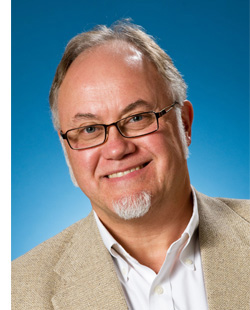 William (Bill) Greener has had a diverse career that has taken him from optics to farming to law school. He is currently a high-tech patent attorney with the law firm of Bond, Schoeneck & King, PLLC. This post has been adapted from an interview with him that appeared in the OSA Rochester section January newsletter.
William (Bill) Greener has had a diverse career that has taken him from optics to farming to law school. He is currently a high-tech patent attorney with the law firm of Bond, Schoeneck & King, PLLC. This post has been adapted from an interview with him that appeared in the OSA Rochester section January newsletter.
OPN: Tell us about your career path.
Bill: I have wanted to be a physicist since I was about nine. I got hooked on optics after constructing a hologram as a sophomore physics major at Canisius College. I earned my M.S. in optical engineering from the Institute of Optics at the University of Rochester, where I learned from top optics experts including Brian Thompson, Rudolph Kingslake and M. Parker Givens. I also took a course with OSA Fellow Duncan Moore.
In 1976, I accepted a job offer from Pratt and Whitney Aircraft in West Palm Beach, Fla. I was part of a team that built and tested the closed cavity of MIRACL (Mid-Infra-Red Advanced Chemical Laser)—a hydrogen-fluoride gas dynamic laser whose 13-in. cavity mirrors were cooled by jet fuel.
After five years in Florida, my life took a different direction. My wife and I moved to New York to pursue another dream—to operate a farm. We enrolled in the agriculture college at SUNY Alfred and farmed dairy calves for the next eight years.
During that time, I also attended law school at SUNY Buffalo, which led to a federal court clerkship, a three-year stint with a small patent boutique law firm, and then a job at Corning, Inc. I was a senior patent attorney in charge of Corning’s worldwide erbium-doped fiber amplifier portfolio. Five years later, I joined Kodak and then Bausch & Lomb, where I managed the ophthalmic laser surgery portfolio.
I joined Bond, Schoeneck & King in 2005. We have a significant intellectual property group that includes 10 U.S.-registered patent attorneys. My primary clients include the University of Rochester, Cornell and the University of Central Florida/CREOL. Some of the technologies I work on include multiphoton and computational imaging, nanophotonics and opto-fluidics.
OPN: How did your scientific background prepare you for law school?
Bill: Law school emphasizes some of the same skills I learned as an engineer: logic, discipline and analytical thinking. What was new to me is the notion that 2+2 can equal whatever you can convince certain others that you want it to be equal to. Facts are always facts, but the laws are different in just about every jurisdiction, and the application of the law to the facts can lead to unexpected outcomes.
I took a systemic approach to problem solving in law school that drew on my experience in the lab and on the farm. In both scenarios, I had to not only address the problems at hand but anticipate all the things that could go wrong—whether they included a dysfunctional laser or a billy goat with its collar stuck in an electric fence.
OPN: What do you do as a patent attorney?
Bill: A typical case starts when I receive an invention disclosure from a client. I meet with the inventor to flesh out the details of the invention and determine the most commercially valuable form for which we will apply for patent protection. This often involves commissioning a patentability search through a professional search firm. At this stage I draft the broadest claims covering aspects of the invention that I believe would be patentable.
Once I and the inventor (and often a licensee) are comfortable with the content and scope of the patent claims, I prepare the specifications and drawings. We electronically file the application in the U.S. Patent and Trademark Office and then wait for at least 12 months to get our first substantive response—which is almost always a rejection of the claim. The examiner provides reasons that she believes render the submitted claims “obvious” or not new. My job is to convince her otherwise. If we are successful, the examiner will eventually send out a “Notice of Allowance.” We pay a fee and the applicant is granted a patent.
I also provide opinions about a client’s right to use their invention. I prepare confidentiality agreements, review contracts, formulate license agreements, and advise clients.
OPN: You’ve described a career that many optics students might not think of.
Bill: Practicing patent law enabled me to integrate my love of science and engineering with tools that make great technology accessible and sustainable. I encourage anyone with a passion for technology and its presence in the real world to explore patent law as a career. I’d be happy to speak with anyone who wants to know more. You can reach me via email at wgreener@bsk.com.
